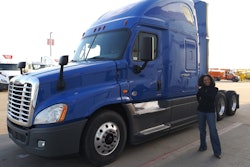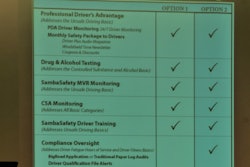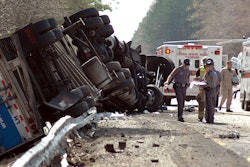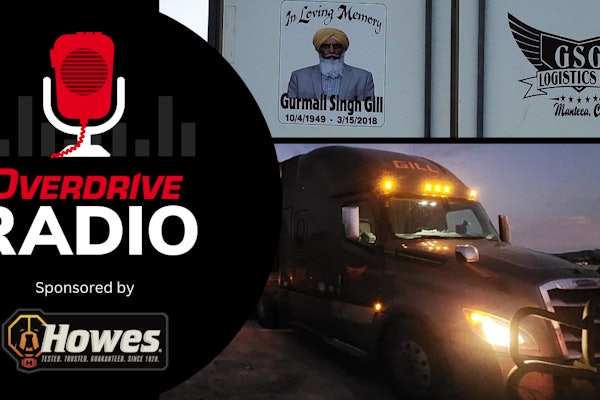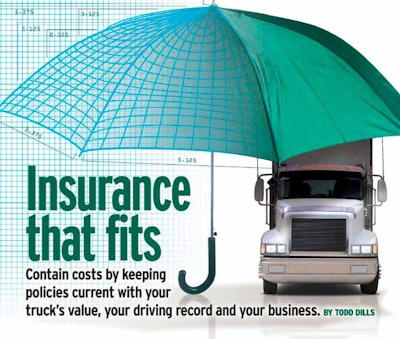
Steve Libertore of National Risk Management Services, an insurance agency headquartered in Ohio, says data from insurers providing commercial auto policies (which speaking broadly includes more than just trucking-related insurances) show a 111 percent combined ratio over the last two years. Being higher than 100 percent, basically, means on average those insurers aren’t making money on those lines of business, Libertore says.
In the trucking market, that’s in part led to situations like that of Wayne VanHooser, detailed on the Channel 19 blog last week, where a few incidents (only one deemed at-fault) for a long-established, long-in-business independent policyholder led ultimately to the insurer opting not to renew the operator’s policy. Attempts to shop the policy around, then, came at prohibitive premium costs well above the level where VanHooser’s previous insurer had covered him.
Libertore says premium increases in the past year have followed among many of the insurers his agency works with, citing 10 percent as a rough average for independents and small fleets.
It’s not hard to find contrary examples on either side of that 10 percent among readers.
One one-truck independent, commenting in the Overdrive‘s Trucking Pro discussion group on Facebook, noted since re-establishing her authority several years back, her policy premium (primary liability plus $150K cargo) costs have in fact done what they’re supposed to do in the absence of blemishes on the record and claims — they’ve gone down. Having started at $14K annually in 2012, she’s now at $11,000.
On the other side of that equation, add in an issue out on the road that causes a claim, or a basic change in the operation, and increases can easily exceed 10 percent. Darren Fite, commenting under the Channel 19 post about VanHooser’s situation from last week, put a driver in a truck he’d previously run himself at a $9,500 annual premium — with a different driver, the cost was $12K, or around a 25 percent increase. He subsequently sold the truck after the driver called it quits after six months. “I guess maybe that was a really good decision,” he wrote.
Looking at the big picture, however, in what Libertore called the last two years’ worth of a “hard market” — unfavorably hard for owner-ops hopeful for a fall in premiums — for commercial auto liability overall not exactly difficult to understand. Root causes of difficulties for insurers in the business of covering trucking companies’ liability needs are multifold, including both “accident severity and frequency” on the rise in recent years with higher speed limits in states and generally more traffic (and more distraction) of all types as economic activity has increased. Other factors Libertore cites:
- The demand for experienced Class A CDL drivers has led some fleets to relax their hiring standards, equating to less experience behind the wheel all around.
- Vehicles themselves are more expensive, thus more expensive to insure when it comes to physical damage and, crucially, more expensive to replace when a loss occurs, driving up liability claims costs, too.
- Accident litigation, driven in part by a kind of me-too effect with well-publicized, high-dollar injury awards in accidents involving trucks, whether the trucking company was primarily at fault or not. The desire to avoid even the possibility of such jury awards puts truckers and their insurance companies under more pressure to settle civil suits — and the higher those awards go, the higher the settlements get as well.
Absent tort reform to limit damages in such suits at the level of government, there’s evidence aggressive shopping can pay off in better insurance premiums for independents with a long history of authority behind them and at least relatively clean claims/safety-data histories, VanHooser’s example notwithstanding.
Another commenter, simply by finding a new agent to help shop coverages, reduced annual insurance premiums for his one-truck business by $4K annually even with an added power unit and driver under the policy.
Another, posting as “Shadow,” illustrated the effect of age and experience on rates: “I have a friend that runs an in-state hotshot business with one older Ford F-350 pickup. He gets a load about twice a month from a local plow business that makes plows for state, county and local trucks. He got stopped one day in a DOT check and didn’t know about carrying liability insurance. He called me up looking for a company to get commercial truck insurance from. I directed him to the agent I used. Mind you I was hauling interstate and him intrastate. He is in his early 70s and me my mid-60s (ugh).”
The company quoted the older, less-active, more local operator at near twice Shadow’s insurance rate for the same coverage. The operator eventually found a better deal, but the initial quote for similar coverage shows the effect of age. “Shop around,” Shadow adds, “check the coverage and see if there are cheaper companies. Common business sense.”
Libertore says that, considered historically, insurance costs haven’t risen nearly at the same rate as most everything else has, fuel and equipment in particular. “When you’re talking about a well-run small trucking company — guys that do not have issues with losses or their safety records – give me a trucking company like that that’s been in business for thirty years. If you look at his mid-90s insurance rates, and they’ve performed well from a safety standpoint, they treat drivers well and have good retention, that trucking company is probably paying maybe a couple percent higher than 20 years ago.”
Well-run, established companies, Libertore believes, just have not seen “the rate increases that a similar company that doesn’t put efforts into driver retention” have seen.
Over that same 20-plus-year period, however, costs for new owner-operator ventures with authority, conversely, have more than doubled, making getting established and quickly expanding doubly difficult from an insurance perspective and illustrating the effects of reduced competition on pricing increases. Libertore says annual $17K-$18K premiums for new owner-operator businesses are not uncommon in today’s market. Part of the dynamic that drives it is the exit of insurance companies from what is considered a losing line of business. Among the many insurers his agency works with, there are only a few who will even consider a new authority.
Further, he adds, “some insurance companies who will write the owner-driven single-unit start-up will only allow you, say, one truck in two years” from an expansion perspective. “If you’ve got high aspirations and want to expand quickly, you’re really limited in the insurance companies that will write you,” ultimately equating to less efficacy for shopping around, and higher costs.
Most such companies re-evaluate new businesses as experienced after two — sometimes three — years, he adds.


